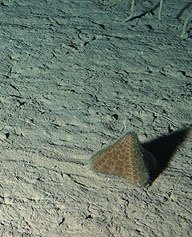Rare feasts never wasted by bottom-feeders
 Researchers have answered some long-running questions over how animals at the deepest levels of the ocean are able to feed themselves – it seems there is a long time between meals, but there is a serious feast when they do arrive.
Researchers have answered some long-running questions over how animals at the deepest levels of the ocean are able to feed themselves – it seems there is a long time between meals, but there is a serious feast when they do arrive.
Creatures on the abyssal plains kilometres below the surface of the ocean are usually fed by what has been pleasantly dubbed “marine snow”.
The snow consists of mucus, fecal pellets, body parts and other edible matter which falls from the more abundant higher reaches of the sea.
Researchers had long wondered how this slow fall of marine snow could sustain the various animals and microbes living in the sedimentary floor.
A new paper by Ken Smith, who has studied activity around the deep-sea research site ‘Station M’ for over 20 years, has shown that sometimes a feast erupts on the bottom of the sea – and all the creatures that live there seize the opportunity to stock up on food.
The team used a combination of technologies to monitor the amount and rate of marine snow falling to the bottom, as well as the abundance and behaviour of deep-sea life at the site 220 kilometres off the Central Californian coast.
Over a single period between 2011 and 2012, three distinct events were captured which delivered huge amounts of relatively fresh food to the deep seafloor.
First, in August 2011, a massive algal bloom near the surface lead to a pile of diatoms drifting to the bottom.
Similarly, from March to May 2012, a large community of salps (gelatinous mid-water animals that eat algae) reproduced rapidly near the surface. The salps proliferated so wildly that they blocked the seawater intake of a nearby nuclear power plant. When the salps in the surface waters at Station M died, they sank so quickly that they carpeted the seafloor.
The third feast came in September 2012, when another algal bloom created so much dead algae that it clogged the researchers' sediment traps, but was captured by a time-lapse camera.
Each time the huge injection of food fell to the floor it was gobbled up just as quickly. The periodic feasts prompted the growth of any deep-sea animals, and the microbes that inhabit the sediment itself.
The intermittent pulses of food were able to keep a cycle turning over which allowed life to continue during the slower years and decades.
Further research will now be conducted into the deep-sea feasts, monitoring the changing aquatic communities that they create, and the possibility that shifting climatic conditions may make the events more frequent.
The new study shows another deeply interwoven layer of biology in the oceans, wherein the seemingly separate worlds at the very highest and lowest levels of the sea are shown to be intrinsically linked.








 Print
Print